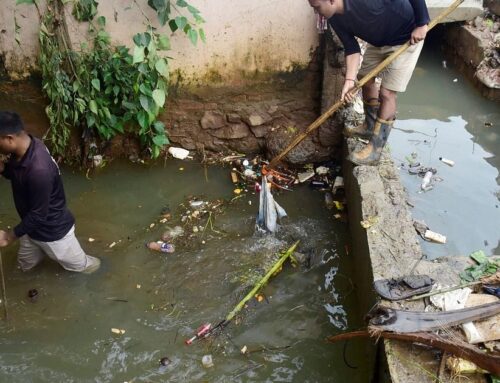Trump administration halts environmental grants, critical projects now in limbo
February 9, 2025
Overview:
– The Trump administration has placed nearly 170 EPA employees on administrative leave and frozen billions in climate and environmental justice grants, potentially disrupting critical projects in low-income and minority communities.
– The move has already caused delays in pollution monitoring, clean energy adoption, and community resilience efforts, with public health experts warning of the dire consequences. The long-term viability of environmental justice protections remains uncertain.
In a sweeping rollback of environmental protections, the Trump administration placed nearly 170 employees in the Environmental Protection Agency’s Office of Environmental Justice and External Civil Rights on administrative leave and froze billions of dollars in climate and environmental justice grants.
The move thrust several projects in Detroit into uncertainty, disrupting efforts to combat pollution and climate resilience in some of the country’s most environmentally burdened communities.
Funds from the Inflation Reduction Act’s Environmental and Climate Justice Community Change Grants, which allocated $81.7 million to Michigan alone, were restricted, with grant recipients unable to access funding for weeks.
Meanwhile, the Solar For All initiative was also affected, which aimed to provide solar energy to nearly 900,000 households. Advocates say the administration’s actions have already caused significant delays in pollution monitoring, clean energy adoption, and community resilience efforts.
Several reports indicate the agency began restoring some grant funding late Friday. Hoover and other advocates warn that the future of environmental justice programs remains precarious.
Partial reinstatement of funds
In a Friday afternoon BlueSky post that the agency’s acting deputy administrator issued a directive to release “any disbursements on open grant awards that were paused.” However, he warned that the Trump administration still intends to target environmental justice grants in the future.
“This #FundingFreeze accomplished nothing but did cause unnecessary chaos and jeopardized thousands of projects to protect public health and the environment,” he wrote in the BlueSky thread. While more grantees are regaining access to funding, how many programs may remain shut down remains unclear.
Michelle Roos, executive director of the Environmental Protection Network, a group of former EPA staffers and political appointees formed in 2017, confirmed.
“To our knowledge, much of the Trump administration’s illegal withholding of obligated funds to communities has been lifted,” Roos wrote in an email Saturday. “Now states, municipalities, nonprofits, and communities can continue to implement much-needed projects to reduce our exposure to toxic pollution and improve our resilience to the impacts of climate change.”
The funding freeze impacted a wide range of initiatives, including clean transportation, pollution reduction, and community resilience projects. According to data shared by Hoover, a total of $18.16 billion in EPA funding was frozen nationwide. In Michigan, 43 environmental justice projects were affected, accounting for $461.2 million in stalled funding. In Detroit, five initiatives—including resilience hubs, clean ports and pollution monitoring—were stalled, with $46.2 million in funds restricted.
Jeremy Orr, who served on the EPA’s National Environmental Justice Advisory Council until last year, told Planet Detroit that while the Trump administration previously ignored environmental justice efforts, it did not actively dismantle them.
“This is nearly a complete 180 from [Trump’s] first term,” Orr said. “[Environmental justice] still existed. It still functioned. People weren’t getting laid off. This is vastly different.”
Sylvia Orduño, a Detroit resident, organizer with Michigan Welfare Rights Organization and former chair of NEJAC, described the decision as a “spiteful directive” that will leave working families without federal protections.
“For many decades, corporations have made record profits by manufacturing products with toxic chemicals, refining fossil fuels, and contaminating public environments,” she said,” oftentimes adjacent to the homes and schools of low-income people.”
Growth of environmental justice under Biden
The Biden administration prioritized environmental justice more than any previous administration, embedding it across federal agencies and directing substantial financial investments into historically marginalized communities.
Through executive orders, Biden institutionalized environmental justice initiatives, ensuring that agencies accounted for cumulative public health burdens. His administration also launched the Justice40 Initiative, requiring 40% of federal climate and environmental investments to benefit disadvantaged communities.
These priorities translated into historic funding, with Biden’s policies directing unprecedented investment into environmental justice initiatives. The Inflation Reduction Act (IRA) and Infrastructure Investment and Jobs Act allocated billions toward supporting clean energy adoption, pollution monitoring, and resilience projects.
According to the Center for American Progress, the Biden administration invested over $148 billion in low-income, Black, brown, and Indigenous communities, with more than $60 billion in clean energy investments reaching areas with below-average median incomes between 2022 and 2023.
Health and environmental rollbacks
Public health experts warn of the dire consequences of rolling these programs back. Michelle Martinez, director of the Tishman Center for Social Justice and the Environment at the University of Michigan, said eliminating environmental justice protections will exacerbate already-high rates of respiratory and cardiovascular disease in frontline communities.
“Trump’s policies will make it dangerous for children, elders, and other vulnerable populations who are at risk of high levels of asthma, heart disease, and stroke from dirty polluters,” she said. “We should be doubling down on clean, affordable water for all—not weakening regulations.”
Lisa DelBuono, executive director of Michigan Clinicians for Climate Action, called the move “an overt step to dismantle a federal office designed to ensure all people have equal access to a healthy, sustainable, and resilient environment.”
She added, “Dismantling the EPA’s Office of Environmental Justice is an egregious act of racism and one that fundamentally goes against the principles that most Americans hold dear.”
Roos called on advocates to “stay vigilant and fight this to the best of our ability.”
“These staff, Including many whose titles include environmental justice, work tirelessly to make sure the most vulnerable populations, including children, the elderly, and communities experiencing a disproportionate exposure to pollution, can breathe clean air and drink clean water,” she said. “This chaotic witch hunt hurts all of us and must be stopped.”
learn more
Poll: Majority of Trump voters want to protect the EPA
Former EPA officials say Trump is likely to press forward with efforts to weaken the agency, while Michigan advocates say budget cuts could impact environmental justice programs in the state.
Coalition unveils initiative to build a network of community resilience hubs on Detroit’s east side
The initiative has received funding commitments totaling $2.7 million from local philanthropic organizations.
Uncertain future for environmental justice protections
So far, the Trump administration has not provided clear guidance on the future of the OEJECR or the fate of previously approved grants. An EPA spokesperson told NPR that employees placed on leave had jobs that did not relate to the agency’s “statutory duties or grant work.”
The funding freeze has already disrupted local projects, including an effort to turn 15 Detroit food pantries into resilience hubs and a Kalamazoo County initiative to conduct energy efficiency upgrades. The resilience hub project, led by a coalition of local nonprofits, is set to receive millions in federal support to create safe spaces for residents during power outages and heat waves, which have become increasingly frequent due to aging infrastructure and severe weather.
Community leaders and lawmakers have vowed to fight the cuts, but the long-term viability of environmental justice protections remains uncertain.
Orduño summed up the stakes. “Without OEJECR, working families in rural, suburban, and urban towns will have little to no protections against environmental polluters and no federal agency to aid them,” she said.
Search
RECENT PRESS RELEASES
Related Post






